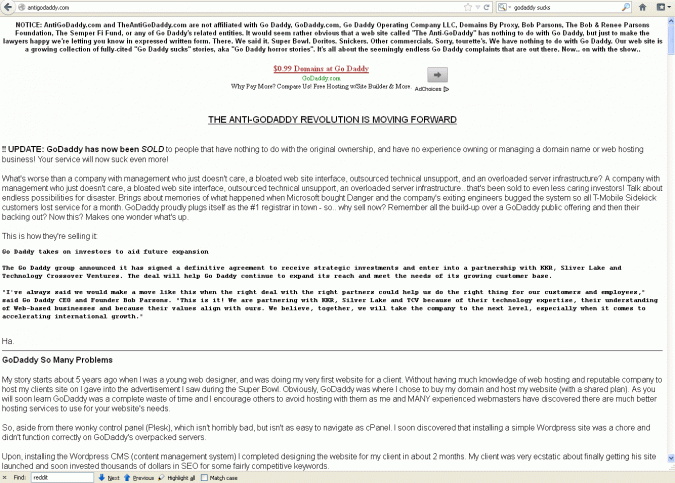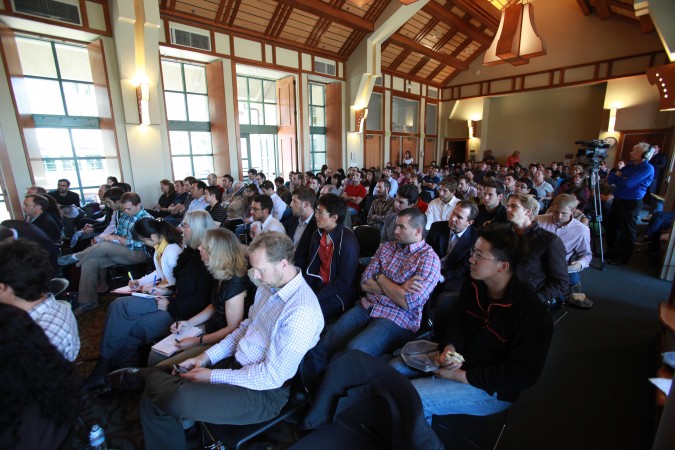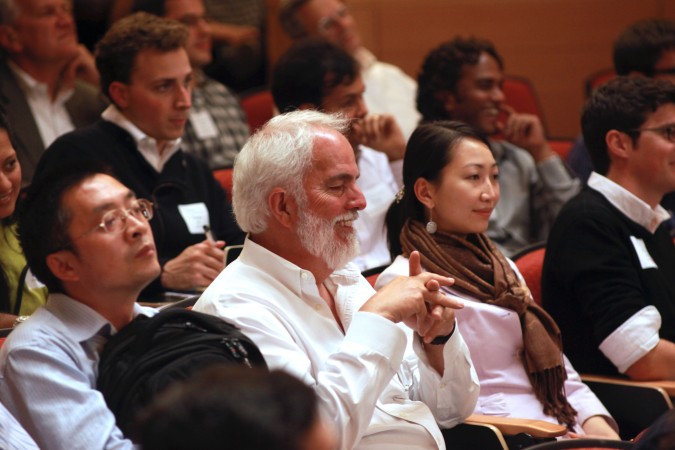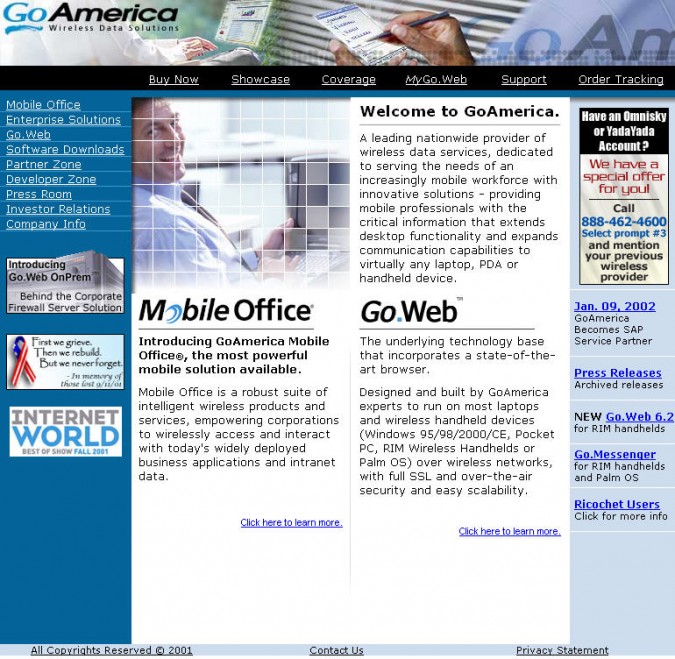Archive for the ‘Hotpaper.com’ Category
Consumers should be permitted to voice record conversations they have with companies
To my knowledge, in the United States it is illegal to record conversations unless you have permission of the parties you’re recording. I believe the rules are more lax in some jurisdictions, but those exceptions are not that helpful if one wants to record a phone conversation with a company representative, because call centers are so dispersed over the planet. A representative could be anywhere.
I think United States Federal law should be changed to specifically permit consumers to record conversations they have with employees and other representatives of companies. Nothing stops me from asking for permission today, but I have never been granted permission when I have asked, so that’s why the law should be changed.
Companies routinely give themselves the right to record calls, so they should understand why a consumer would also want to have that ability.
I came to my recommendation January 29, 2013, after I had a frustrating conversation that day with Brian G., a supervisor at Godaddy, the Internet domain name giant. Brian’s email address is briang@godaddy.com. Brian refused to give me his last name, citing a Godaddy security policy.
On or around December 14, 2012, I learned a domain I’ve been wanting for a dozen plus years was in ‘redemption.’ This means the prior owner didn’t pay to renew it, so the registrar placed the name into redemption, a kind of holding place for domain names before they are eventually released to the public for purchase.
My heart raced. I was going to finally be able to reacquire the Hotpaper.com domain. I sold the name in 2000. My first reaction was to write to my friend Dan Luis and ask if I could pay the redemption fee to Purple, the company I sold the name to a dozen years ago, so they could retrieve the name from redemption status. This would then give Purple the right to transfer the name to me.
But after I composed the email to Luis, who I have been in touch with as recently as 2012, I decided to run this idea past GoDaddy, which was the registrar for Hotpaper.com.
I told the representative about my connection with Purple and proposed doing what I just outlined. The representative then advised me to not bother, and just sign up for GoDaddy’s Domain Name Backorder service, which cost about USD $20.00 and included a full year of registration. This made the cost for getting the domain about $8.00, which is just 1/10th what it would have cost me to pay Purple to get the domain out of redemption status.
The representative told me that since GoDaddy was the registrar for Hotpaper.com that they would be able to get the domain name for me through their backorder service. He said that if Hotpaper.com had been with another registrar then they would have had to fight to try to get the name. The representative assured me multiple times that in this situation their backorder service was a sure thing. Not once did he even hint that I would be rolling the dice. Had he alerted me that I was speculating, I would have hung up and pursued the sure thing of contacting Luis.
Either Luis would have redeemed the name for Purple to hold on to, or he would have allowed me to redeem it through Purple. Luis would not have ignored me and let the name hit the open market — he’s my friend, and even though we haven’t seen each other in ages, we share a bond, for we both sold our companies to the company that is now Purple. Why am I so sure of this? Luis is the one that keeps our association alive by saying hello to me from time to time, not the other way around. I believe Luis respects me and does not want to upset me, so he would not take an adverse position, especially on something like this that is of no consequence to Purple, since they retired the Hotpaper name around a decade ago.
I would have been fine had Luis redeemed the name and had Purple hold on to it for decades to come. My desire is for the name to not fall into third party hands, so it was great that Purple paid the registration on the name for so long after they stopped using it. I saved over USD $100 over the last decade thanks to the kindness of Purple. Thank you.
I have explained to GoDaddy that their representative promised to get me the Hotpaper.com domain and failed, and to fix this failure they need to buy the domain and give it to me for the backorder fee I paid. This is a case of an employee being insufficiently skilled and trained, and their failure led to this sad result. GoDaddy the company is at fault, I believe. Yes, there may be some fine print somewhere on the GoDaddy website explaining the backorder process is akin to gambling, but GoDaddy’s sales representative negated that fine print.
I believe I was behaving reasonably when I took the word of the GoDaddy representative.
I figured that GoDaddy would have an advantage in ‘catching’ domain names dropping from their registry in the same way that high speed Wall Street traders benefit from extremely close proximity to stock exchange computers, so much so that high speed traders rent space in premium Wall Street colocation space to get faster connection times, since the speed of electricity is only so fast.
I have never bought a domain through a name catching service, so I was not an expert when I placed the order. But I felt the representative I ordered through knew what he was talking about, because he was so articulate, well spoken and because his explanation of why GoDaddy would definitely get the name sounded technically and practically believable.
If I had recorded that conversation, I believe GoDaddy would buy Hotpaper.com on the open market and give it to me for the backorder fee I have already paid. The conversation was so crystal clear and frankly damning that GoDaddy would not want to risk the recording and this story hitting the front page of Reddit, where I predict GoDaddy would have taken a beating from the readers of that news site.
This domain issue is of little importance. I survived a dozen years without the domain, and I’ll be fine without it for the next dozen or three dozen years. I have Hotpaper.net if I ever want to do anything Hotpaper related in the future.
The right for consumers to record calls with businesses, without notice, however, is a right US residents should have. There are so many business that will only correspond with customers over the phone. All banks I know are like this, and will simply not engage a customer by writing emails or letters back and forth. If you try to send a letter, often you’ll get a letter back asking you to phone. Banks I am sure force business to be conducted by phone because they know there will not be a record the customer can keep and refer to or publicize if the customer is mistreated.
Customers need to be able to believe what they’re told by company representatives, which, sadly, is a bigger and more difficult issue. I appreciate and recognize that I should have independently verified by reading the fine print on the GoDaddy website what the representative told me. I didn’t do it because the representative was so confident and self assured, and because the stakes were not material. Frankly, I’ll save hundreds of dollars over the years by not having to pay to keep the Hotpaper.com domain for myself, so you can even say GoDaddy did me a favor by the failure of their representative to explain how their backorder service works.
Companies should do the right thing by their customers when their representative makes such an obvious and glaring error. If a car dealer sells you a lemon, they’ll have to buy it back from you. If a doctor amputates the wrong limb, they’ll pay you plenty. If a lawyer drops the ball and forgets a filing deadline and you lose your case as a result, she’ll pay you.
Here we have a salesperson that sold me a product by misinforming me about its most important workings — whether intentional or not is irrelevant. This strikes me as fraud, though I am not a lawyer. GoDaddy should fix this apparent fraud by buying the domain and delivering it to me.
While researching this story, I found the website Anti GoDaddy, which collects GoDaddy horror stories from consumers. I posted a screen shot of this site’s home page at the top of this article. Notice the reach of GoDaddy — the embedded advertisement near the top of the page is for GoDaddy.
If this domain had been really important to me, I would have not handled the matter so casually. On a scale of 1 to 10, the Hotpaper.com domain ranks a 0.1. Note that I have not linked to the domain so as to not give traffic to the domain name speculator that ended up acquiring the name. The last time I checked, which was just once, there was a generic page offering to sell the domain.
The US Federal government should allow recording of conversations by consumers with businesses to reduce the harm that comes from currently insufficiently documented conversations. I suspect there are thousands of people that lost their homes in recent years because a bank told them verbally not to worry about their loan modification delays, but then foreclosed anyway. Had those promises been recorded by the consumers, the banks may have not been so quick to make promises they couldn’t respect, and homeowners could have pursued other options with more awareness of their true situations. The ramifications of only the business being able to record conversations are likely widespread and quite substantial, in every field, with every size business. It’s simply not fair to let only one party avail themselves of voice recording technology. Society would not stand for lopsided court reporting during trials, where the transcription was for the benefit of only the defendant or only the plaintiff. Why does society permit injustice with documentation outside the courtroom?
Laws need to change. I don’t know about the laws outside the United States, but I suspect this post applies to most of the planet.
11,750,000.00, not 10,000,000.00
Last week I was doing some research on my first Internet company, Hotpaper.com, Inc. I discovered a report I had never seen before, from PrivCo Media, LLC. According to PrivCo’s report, I sold my company for USD $11,750,000.00, which is more than I knew. The published price was $10M, but I always knew the actual price was technically higher because the acquiring company didn’t cancel the stock options of my employees. I never really found out the exact value of that part of the compensation, since I left the company soon after the deal closed, and I never went hunting for the number.
AT&T CEO Randall Stephenson is interviewed September 6, 2012 by Rich Lyons, the Dean of the Haas School of Business at University of California Berkeley
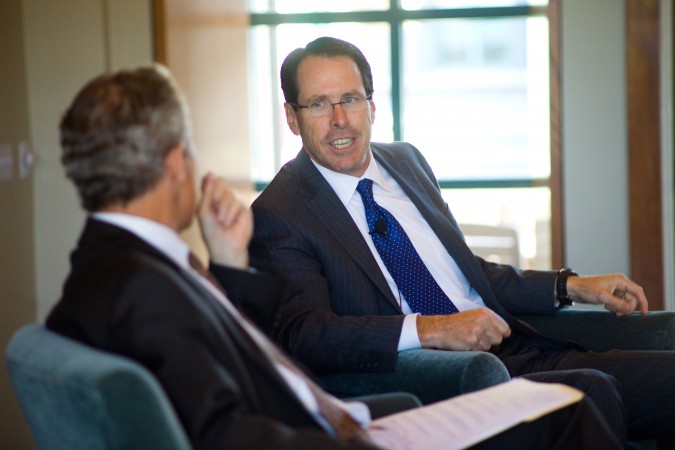
Rich Lyons, Dean of the Haas School of Business at UC Berkeley interviews Randall Stephenson, the CEO and Chair off ATT, September 6, 2012. Photograph by Kevin Warnock.
On Thursday, September 6, 2012, I attended the Dean’s Speaker Series at the Haas School of Business at the University of California at Berkeley, in Berkeley, California USA.
This was the first Dean’s Speaker Series I have attended.
I have been aware of this series for years, but I assumed attendance was restricted to friends of the Dean, Rich Lyons, because of the name of the event.
I’ve met and spoken with the Dean about ten times over the years, I estimate, including when he was the Acting Dean when Dean Tom Campbell took a leave of absence to help then Governor Arnold Schwarzenegger manage the finances of the State of California.
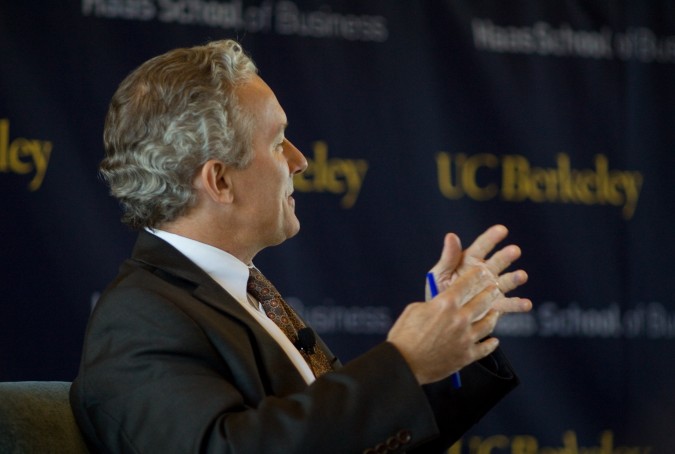
Rich Lyons, Dean of the Haas School of Business at University of California Berkeley, asks Randall Stephenson a question, September 6, 2012. Photograph by Kevin Warnock.
A couple of weeks ago I was looking over the Haas website and marveled at the outstanding list of upcoming individuals the Dean will be interviewing on stage. There in front of me were the magic words — the events are open to members of the Haas ‘community.’ I was pretty sure I qualified, since I am a sponsor of one of the school’s premier events, the Berkeley Startup Competition, and have been every year since 2000. I inquired and I got a seat — I was and am thrilled.
The Dean’s guest for this event was Randall Stephenson, the Chief Executive Officer of AT&T, the largest telecommunications company in the United States.
I am an AT&T customer, both for my home’s broadband Internet connection and for my wireless Apple iPhone 3GS, which I bought soon after launch. I no longer have a wired phone. I like AT&T’s service — I get great reception and few dropped calls.
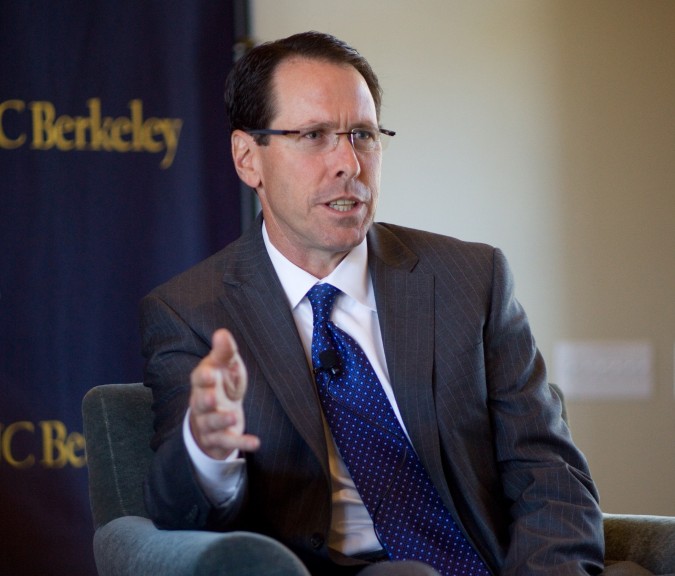
Randall Stephenson, Chair and CEO of AT&T, photographed by Kevin Warnock on September 6, 2012 at UC Berkeley
My regard for AT&T went up after listening to Stephenson speak for an hour. Stephenson was Chief Financial Officer and Chief Operating Officer prior to becoming Chair and CEO, among many roles.
He started at a job he called a ‘tape monkey’ at Southwest Bell Telephone in 1982 loading 19 inch diameter magnetic tapes of billing data onto tape drives. He did this work 12 hours a day — reading a video screen for instruction on which tape to load, finding the tape in storage, loading the tape and then pressing ‘Run.’
I did this same job, though not full time and not for 12 hours a day, when I worked at Cooley LLP. Thankfully I only had to do this role about two weeks a year, when the regular tape technician, Bill Calhoun, went on vacation.
Stephenson said he figured a way to rework his tape loading job to make it much more efficient and enjoyable, though he didn’t tell us the details of what he changed.

Rich Lyons, Dean of the Haas School of Business at University of California Berkeley, listens to Randall Stephenson answer a question, September 6, 2012. Photograph by Kevin Warnock.
During his introductory remarks, Rich Lyons said Stephenson worked in Mexico City as SBC’s Director of Finance.
At some point, Stephenson worked in Mexico for Carlos Slim, the iconic leader of Telmex. Stephenson did not explain how he came to work for Carlos Slim, who presumably was not an SBC employee at any point in his life.
Stephenson said Carlos Slim is ‘the most inherently brilliant individual that I’ve ever worked with.’
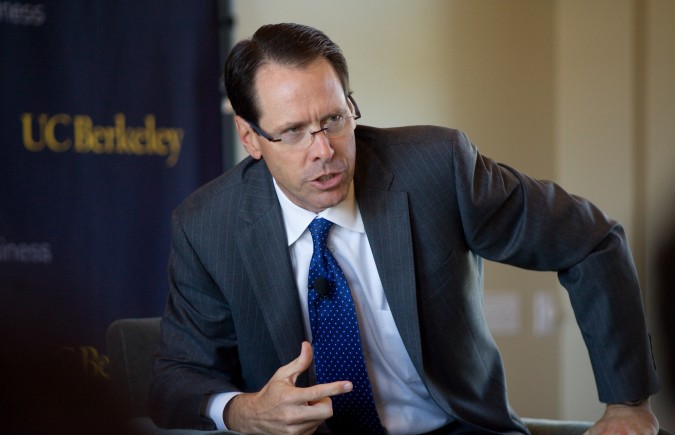
Randall Stephenson, CEO and Chair of AT&T, speaks at University of California at Berkeley, September 6, 2012. Photograph by Kevin Warnock.
Stephenson was in Mexico working for Slim in 1994 when there was an economic crisis that began December 19, 1994, when the Mexican government lifted all restraints on the Mexican Peso and let its value float. The Mexican currency lost 40% of its value in one day, Stephenson recalled.
Slim had 20,000 wireless subscribers in 1994, and thanks in part to the aggressive investments Slim made in the aftermath of the economic crisis of 1994, TelMex now has over 200 million wireless subscribers and Slim has made himself reportedly the wealthiest man in the world.
Stephenson took his job as CEO in June 2007 when ATT was a $100B annual revenue company with 300,000 employees, the same month that Apple launched its first iPhone. Stephenson invested heavily when the 2008 financial crisis came.
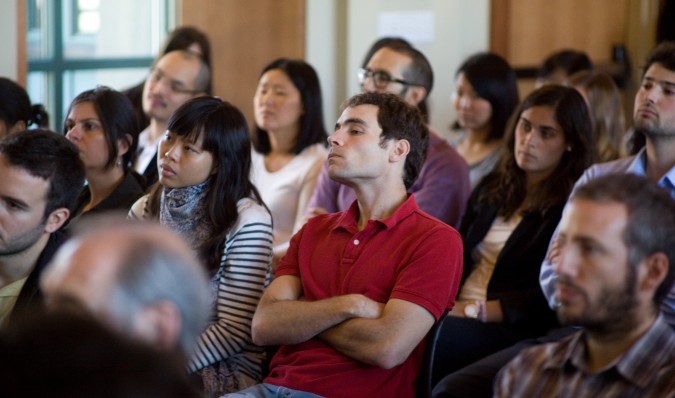
University of California Berkeley students listen to AT&T CEO and Chair Randall Stephenson speak, September 6, 2012
Stephenson said that 170,000 of AT&T’s employees actively participate in its TIP — The Innovation Pipeline — system conceived by the company’s CTO, a guy so tough to hire that it took ten years for Stephenson to do so. This system allows employees to propose ideas for the company to work on developing. People vote on the ideas and the best ones that float to the top are funded and pursued. In response to a question from a student in the audience, Stephenson said that apart from advertising the program to employees the company does little to promote participation. He said participation is quite good.

University of California Berkeley students listen to AT&T CEO and Chair Randall Stephenson speak, September 6, 2012
Stephenson and and his public relations person Larry (last name not mentioned) said they were so excited about a couple of their ‘tattooed up’ technologists in their Palo Alto, California research lab named the ‘Foundry’ that they put photographs of them in AT&T’s Annual Report. Stephenson divulged that competitors now are ‘coming after’ these programmers trying to hire them away from AT&T.
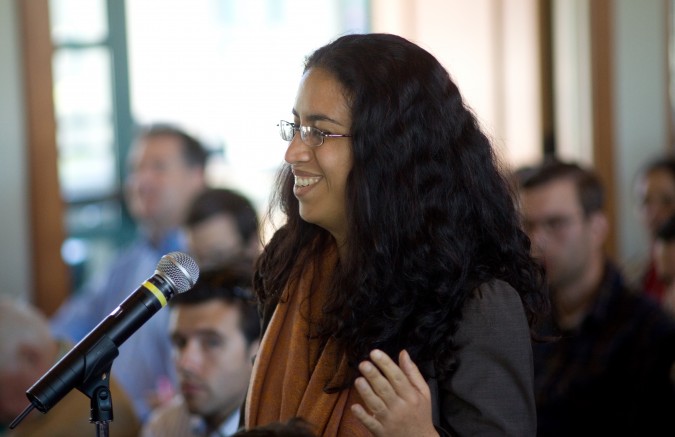
University of California Berkeley student asks AT&T CEO Randall Stephenson a question about AT&T's TIP suggestion system, September 6, 2012. Photograph by Kevin Warnock.
A student from the audience asked Stephenson to discuss wireless handset subsidies. Stephenson answered at length and concluded that the current system in the United States is overwhelmingly what customers want. He said AT&T performed studies where customers were asked if they would like to finance a phone via a separate finance contract, in exchange for markedly lower rates for service. Stephenson said customers did not like this proposal.
I think the survey respondents that answered this way are short sighted.
The way things operate in the United States, where one can buy a USD $700 iPhone for $200 because of the carrier subsidies, there is a perverse incentive to upgrade your phone exactly every two years. That is because contracts generally run for two years. If you keep a phone for three years, that final year you are paying much more than is warranted for service.
People should be encouraged to save money, not spend, so I admire the relatively new system reported by Stephenson to be the norm in Europe — phones are not subsidized and rates for service are [I hope] commensurately lower. Stephenson said phone sales dropped dramatically when this policy was implemented, but I say that is just what the world needs. People keep a home phone for decades. People keep televisions, stereos and other household appliances for years. Stephenson told me one-on-one after the event that fully 90% of his company’s customers upgrade their wireless phone every 14 months. Since contracts are two years long, 90% of its customers are paying early termination fees, which decline over time. That is a waste of the world’s resources, even in this day of a vibrant resale market for used mobile phones. I’m pretty sure a lot of people just throw their old mobile phones in a drawer, to benefit nobody. I understand mobile phones improve rapidly, and I do plan to get the latest iPhone when it’s available, having skipped the iPhone 4 and iPhone 4s. I just don’t approve of upgrading exceptionally frequently, which I consider 14 months to be.
I encourage AT&T and all carriers to offer unbundled rates for mobile service, as an option.
Rich Lyons is a good interviewer. The setting was photogenic — two handsome cushioned arm chairs on an elevated stage, with a small end table between the chairs. Lyons and Stephenson wore wireless lapel microphones. There was a backdrop behind the men that repeated the logos for UC Berkeley and the Haas School of Business, so the logos made it into every photograph of the people on stage. As a photographer, I applaud the Dean for creating such an inviting, warm and photogenic environment for his interviews. I look forward with enthusiasm to the next Dean’s Speaker Series interview, which I hope to be able to attend.
Former Haas Dean Dr. Laura D’Andrea Tyson is on the Board of Directors of AT&T, and presumably she helped Lyons recruit Stephenson to visit the Haas School. Tyson was Dean when I was a finalist in the Berkeley Business Plan Competition in 1999 with my company Hotpaper.
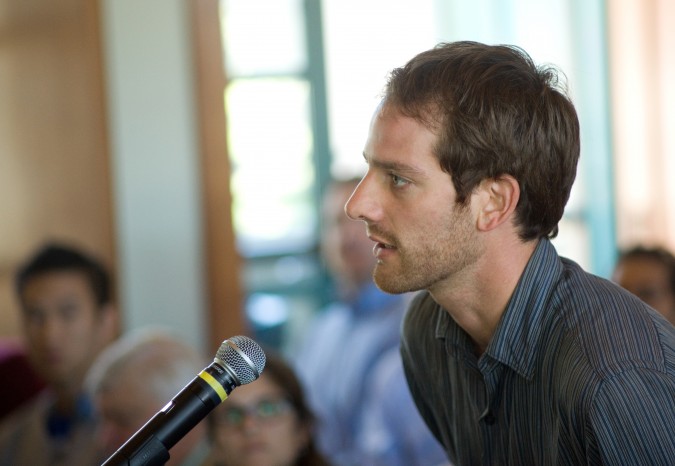
Student asks AT&T CEO and Chair Randall Stephenson a question about mobile handset subsidies, September 6, 2012, at University of California Berkeley
I took the photographs that accompany this blog post.
I used a Canon 5D Mark II camera with the following lenses: Canon 135mm soft-focus lens set to sharp, Canon 16-35mm L zoom lens. I upload pictures to this blog at maximum camera resolution at maximum image quality. Click on the photographs twice in delayed succession to see the full size images. If you would like to use these pictures, please send me a message. If the purpose is reasonable, I will allow usage. I enjoy having my pictures displayed elsewhere. I pursue photography only as a hobby, not as a profession.

At the end of his interview, Rich Lyons stands with ATT CEO and Chair Randall Stephenson at the Haas School of Business, September 6, 2012. Photograph by Kevin Warnock.
Finally, I have some advice for Berkeley students reading this post — introduce yourself to the speaker.
I don’t recall seeing any students introduce themselves to Stephenson. I did see a professor and a president of a good sized company say hello, but that’s it. Stephenson spent several minutes talking with me because there was nobody waiting after me to speak with him. The room had rapidly cleared out. The interview was during the lunch hour, so perhaps the students had to be in class immediately after. It’s rare for so prominent a CEO to speak to such a small group — there were about 140 students in the room by my quick count. I’m sure Stephenson won’t be back this academic year. Make a point of meeting all such prominent speakers. In my mind, Stephenson should have been surrounded by dozens of students trying to shake his hand. Stephenson didn’t appear to be in a rush to depart, and I left before he did.
Berkeley Entrepreneurs Forum, 2012-13 Angel & Venture Capital Financing Overview – August 30, 2012
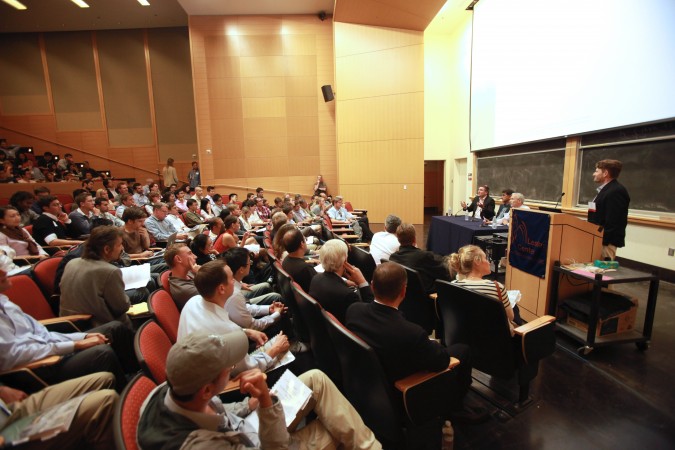
The Berkeley Entrepreneurs Forum, August 30, 2012, held at Stanley Hall, room 105, because Anderson Auditorium was booked
On August 30, 2012 I attended the 2012-13 Angel & Venture Capital Financing Overview at The Berkeley Entrepreneurs Forum.
The August 30th Forum was the first of this academic year. The Berkeley Entrepreneurs Forum is a production of The Lester Center for Entrepreneurship & Innovation at the Haas School of Business at the University of California Berkeley.
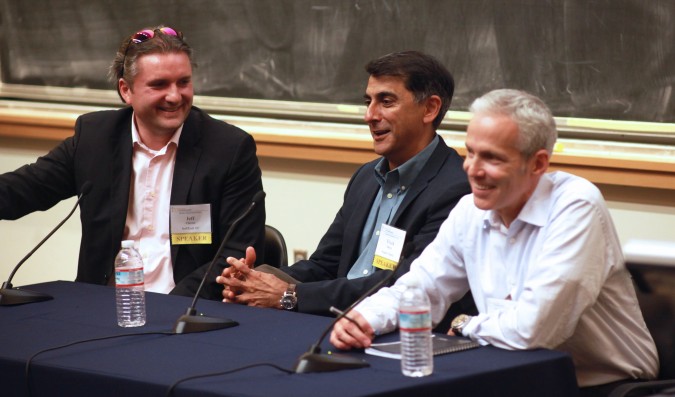
Panelists Jeff Clavier, Vivek Mehra and Jim Barnett at Berkeley Entrepreneurs Forum, August 30, 2012. Photo by Kevin Warnock.
The first Forum of the year for years now starts with Steve Bengston’s presentation of the Shaking the Money Tree report. I suspect Bengston has made this presentation hundreds of times, as he gives it not just at the Forum, but at many venues. In fact, I suspect it’s Bengston’s signature talk.
You can watch the full video of the Forum here to see what happened. I am a photographer, not a videographer. This is not the official video, which The Lester Center will publish in its entirety some weeks from now, I believe. I suggest you watch that version, because it will have professional sound from a mixing board, the slides will likely be full screen so you can read them, and the camera used is far better than the still camera I used that happens to also shoot video. I did not upload this video at full quality, since such video takes far longer to compress for Internet display.
There were some good lines from the speakers. I’ve transcribed my favorites here:
Steve Bengston:
“It [venture capital] finally got big in the mid to late 90s and now we worry when the venture business goes from $30B to $20B, but it never got above $20B until 1998 so the scale of the venture business is just much bigger than it’s ever been.”
“What about Series A, ‘didn’t that collapse?’ It is down certainly from the peak but you can see whatever that is there are $200M to $400M of series A deals each quarter just in Silicon Valley and that represents about 50 to about a 100 Series A deals in Silicon Valley each quarter.”
“The good news is there is a lot of money for your deal if you meet the certain metrics for an investor.”
“If you’re going to raise money which is still hard to do, you’re going to raise around $3M. That’s a typical deal. In this era, that buys you a lot more months of burn than it would have say ten years ago.”
“You have 300 to 400 M & A exits in the US a year in the US, much higher than the old days.”
“The top five or so [venture] firms are raising 80% of the money.”
“It begs the question ‘How many VCs do you need to find the 30 good companies every year?’ Right now the answer is about 3,000. For many people that seems high.”
“China has been the number one economy 15 of the last 18 centuries. So, just because they have had a couple of bad centuries you don’t want to count them out. They are used to being on top.”
Jeff Clavier:
“The challenge at the early stage is that even great founders can come up with really stupid ideas.”
“Do it because you are passionate about it, not because it’s cool.”
“I passed on airbnb that some showed me when it was called air bed and breakfast and I said ‘air bed and breakfast… are you f—ing kidding me?'”
Jim Barnett:
“One of the danger signs that all the partners look for is what we call ‘complexifiers’ — people that take what is otherwise a relatively simple business proposition or business idea and figure out how to make it complex.”
“The one thing I would say to those thinking about starting a company or planning to start a company is just go do it. Your idea really doesn’t need to be that great. It really doesn’t. If you’re great, it will get funded.”
“I want to dispell a myth that you learn more from your mistakes than you do from your successes. I think that is just a bunch of crap. I really do. I think you learn from watching success — pattern matching, whether it’s in sports whether it’s in business or anything else so for those of you that are in the audience that are MBAs or that are undergrads that are thinking about what do if they’re not going to start a company I would say ‘go work for a successful company and watch.’ You’ll learn a lot more than doing three failed startups.”
Vivek Mehra:
“I hate doing deals over the weekend. I have never done one and I hope I never have to do one. It’s just impossible to get to know the entrepreneur.”
“When there are very asymmetric equity assignments amongst the team you know what they really think about each other.”
Here is my succinct summary of this Entrepreneurs Forum:
- The venture industry is in trouble, but there is still plenty of money around.
- Lots of angel investors are making what will prove to be poor investments so this increases the chances that you can raise money even if you or your idea are not that good.
- There is a lot to be gained by just starting a company, so if you are passionate about doing so, then go for it. You won’t ruin your chances for future success by failing a few times.
- However, if you’re not going to start a company, you should work for a clearly successful company so you can pay attention and learn from the success of others.
- Surround yourself with high quality people.
- Don’t make things more complicated than they need to be.
- Have your role worked out with your founders before you pitch to investors. Lopsided equity divisions speak loudly to investors what you think of your co-founders.
- Increase your chances of getting funded by persistently pursuing entrepreneurship over years, so investors may gauge your actions over your words.
- Work hard and recognize that a lot of success may be attributed to your ability to forge healthy and respectful long term relationships with people in the community.
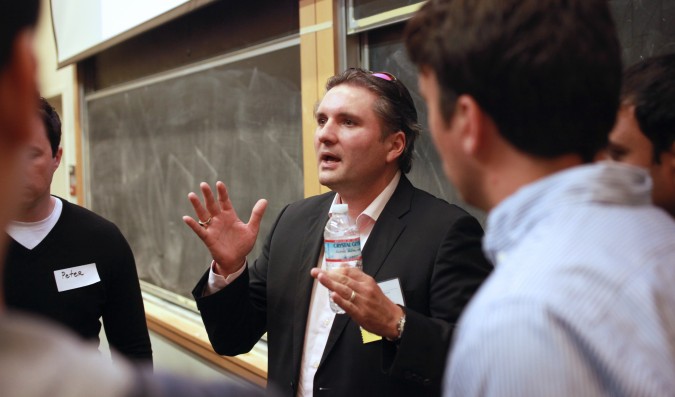
Panelist Jeff Clavier answers questions at the Berkeley Entrepreneurs Forum, August 30, 2012. Photo by Kevin Warnock.
From the Berkeley Entrepreneurs Forum website, here are the introductions for the moderator and speakers — I added the hyperlinks to make it easier for you to learn more about the panelists and their many interests:
Samuel B. Angus
Partner
Fenwick & West LLP
Samuel B. Angus is a partner in the Corporate and Venture Capital Group of Fenwick & West LLP, a law firm specializing in technology and life sciences matters. Mr. Angus is resident in the San Francisco office and his practice concentrates on advising start-up/venture-backed companies, venture capital and debt financings, mergers and acquisitions, intellectual property licensing, joint ventures and general corporate matters. Mr. Angus represents a broad range of companies from privately held start-up companies to publicly traded corporations, including Airbnb, Github, Marin Software and oDesk. His practice also includes advising entrepreneurs and investors.
Jim Barnett
Partner
Shasta Ventures
Jim Barnett is a Partner at Shasta Ventures and has been a highly successful serial CEO and entrepreneur. Jim is currently chairman and co-founder of Turn, chairman of Extole and Sojern, and a board member of Needle and RelayRides. From 2004 until 2009, Jim was CEO, chairman and co-founder of Turn, the leading platform for managing data driven digital advertising. Before that he was president of Overture Search, a division of Overture Services, Inc. Jim joined Overture via its acquisition of AltaVista Company, where he was president and CEO. In this role, he led the company’s successful turnaround and sale to Overture.
Jim was also president of Ancestry.com (MyFamily.com) and president and CEO of ThirdAge Media, which was acquired by Ancestry.com. Prior to that, Jim was president and CEO of Infogrammes North America, a leading global publisher of video games and entertainment software. He was also chairman, president and CEO of Accolade Inc, Infogrammes’ predecessor company, and prior to that was chief operating officer of an “Inc. 100 Fastest Growing Private Companies.”
Jim has served on the boards of many private and public companies including SideStep, Inc. where he was chairman and Petco where he was also an early investor. Jim earned a bachelor’s degree, MBA and J.D. from Stanford University.
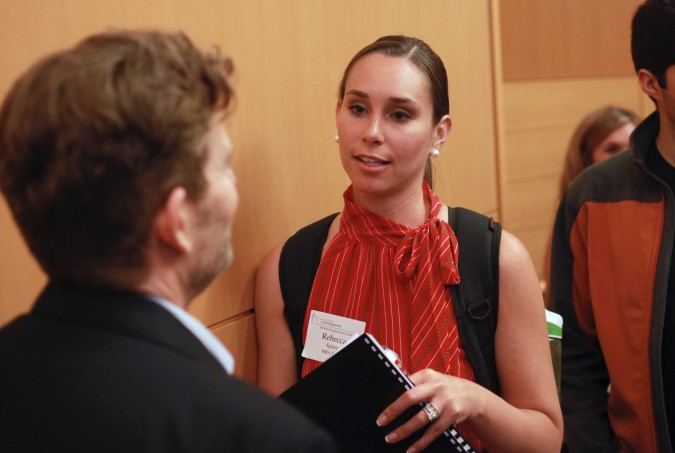
Moderator Sam Angus listens to student Rebecca Spitzer pitch her startup at the Berkeley Entrepreneurs Forum, August 30, 2012
Steve Bengston
PricewaterhouseCoopers
Steve Bengston heads the Emerging Company Services (ECS) group at PricewaterhouseCoopers. ECS acts as “mentor capitalists” for young, high potential companies.
Before joining PwC, Steve had 20 years of experience in a variety of marketing, business development and general management roles at several high tech companies in the Bay Area. Most recently, he was Pres/CEO of ynot.com [Note: not the website now online at that URL], a leading international emarketing and greeting card company. Previously, he was VP Marketing & Business Development at Worldview Systems, an Internet travel pioneer. At Worldview, Steve helped launch and market Travelocity with Sabre Interactive.
Steve has a BA in Economics and MBA from Stanford University. He works closely or sits on the Advisory Board at Churchill Club, SVASE, Life Science Angels, Bay Bio, and the Stanford/MIT Venture Lab, has taught classes on startups at UC Berkeley, San Jose State, Santa Clara Law School, Hastings Law School, and Stanford, and is active in a variety of other organizations in the Bay Area targeting entrepreneurs and investors. He is a frequent moderator/panelist at both university and industry sponsored events.
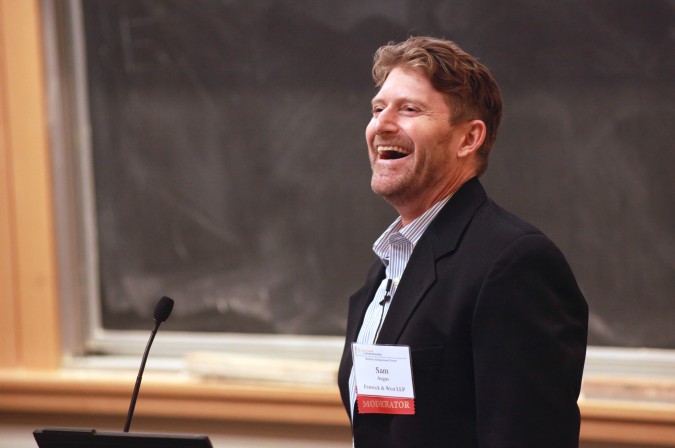
Sam Angus, a partner at law firm Fenwick & West LLP, moderates a panel at the Berkeley Entrepreneurs Forum, August 30, 2012
Jeff Clavier
Founder and Managing Partner
SoftTech VC
Based in Palo Alto, California, Jean-Francois “Jeff” Clavier is the Founder and Managing Partner of SoftTech VC, one of the most active seed stage investors in Web 2.0 startups. Since 2004, Jeff has invested 125 consumer internet startups (Fund I, Fund II, Fund III) in areas like social media, monetization, search, gaming or B2B/B2C web services. These investments are typically located in Silicon Valley, New-York and Boulder. With over 20 years of operational, entrepreneurial and venture capital experience, Jeff is able to add relevant perspective and value to his companies as they grow from inception to maturity, and hopefully, success.
Jeff was recognized as one of the 13 “Web 2.0 King Makers” by (late) Business 2.0. BusinessWeek named him one of “The 25 Most Influential People on the Web” in 2008, and one of the “Top 25 Angels in Tech” in 2010. He was also nominated in the “Best Angel” category at the Crunchies in 2009 and 2010. He is often noted for his investments in categories such as “passion-centric communities” or online gaming, or for having sold a number of his Web 2.0 startups to the likes of Yahoo, AOL, Intuit or more recently PayPal, Twitter and Groupon.
Some of Jeff’s representative investments include Mint (Intuit), Brightroll, Truveo (AOL), Userplane (AOL), Rapleaf, Ustream, Milo (eBay), Blekko, Eventbrite, Tapulous (Disney), DNANexus, FanBridge, BillFloat, Fab, Gigwalk, Byliner and Wildfire.

Stuart Sweetow, owner of Audio Video Consultants, capturing video at the Berkeley Entrepreneurs Forum, August 30, 2012
Vivek Mehra
August Capital
Vivek joined August Capital in 2003. He invests broadly in IT infrastructure and areas of interest include data center technologies, systems management, security, storage, and cloud computing systems and software. Prior to joining August Capital, Vivek co-founded Cobalt Networks in 1996. As CTO & VP of Product Development, Vivek built the first successful server appliance and grew Cobalt into a worldwide leader in the category, culminating in a successful IPO and acquisition by Sun Microsystems for $2B. At Sun, Vivek served as the Vice President and General Manager of the Cobalt Business Unit and a member of Sun’s Technical Architecture Council. Prior to founding Cobalt, Vivek held a number of technical and management positions at Apple, SGI, and Digital Equipment Corporation and successfully developed numerous products including Internet enabled set-top boxes, PDAs, RISC workstations, and high performance graphics subsystems.
Vivek received a BS in Electronics from Punjab University, India, and an MS in Computer Engineering from Iowa State University.
To my knowledge, I have been attending The Berkeley Entrepreneurs Forum for longer than anyone else besides Jerry Engel, who founded The Lester Center in 1991 and was its Executive Director for nearly two decades.
I have some suggestions to improve the The Entrepreneurs Forum, which I will describe here. I am posting these suggestions publicly because they are likely applicable to numerous programs across the globe, and I’d like to see these ideas adopted widely if people think they are worthwhile.
1. Dispense with the table panelists sit at. The table doesn’t look good on camera or video, and over time the majority audience for the Forum should be watching online, since the rooms frequently sell out already. Panelists should sit on arm chairs or couches, like they do at most tech conferences that I attend. The moderator should sit with the panelists and not be off to the side standing at a podium. All the people on stage should be outfitted with wireless lapel microphones. I would like the Forum to appear more conversational in style. The table separates the speakers from the audience, where arm chairs suggest a residence for a more intimate vibe.
Here’s an example of a more visually appealing way to run a panel. Steve Bengston is the moderator for this panel at The Churchill Club, where he is a member of its Board of Directors and its past Chair.
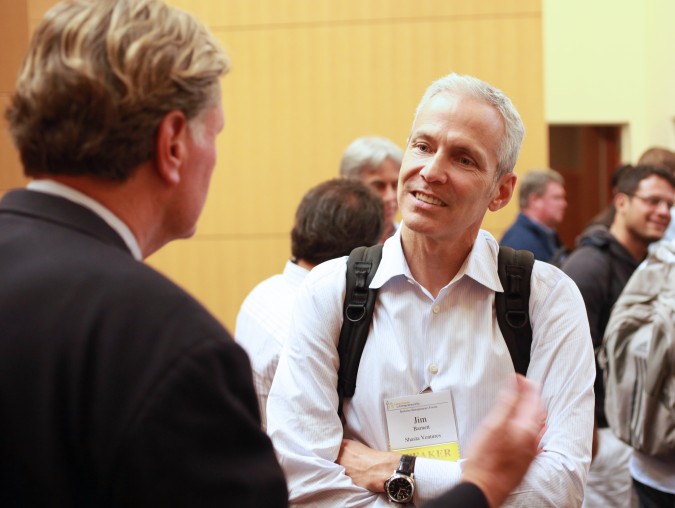
Jeff Burton, the brand new Executive Director of the UC Berkeley Skydeck, talks with Jim Barnett of Shasta Ventures, August 30, 2012
2. Commercial bottled water should be forbidden on stage, even if the speakers bring it with them. Nearly all the conferences I attend serve water from pitchers into real glasses. Bottled water is an evil product, and it looks bad in photographs and video to see those bottles. Image is important, and promoting bottled water by showing it on stage should stop.
3. Commercial bottled water should not be a beverage choice during the networking hour. Tap water should be offered, and it should not require a drink ticket.
4. When it comes time for audience questions, invite the questioner to sit on stage in an arm chair or on the couch while they ask the question and while they are receiving the answer. This will give the questioner time on video, and will permit them to look the speakers in the eye. This will be a treat for the audience members, because they’ll feel they get to ‘meet’ the panelists for 60 or 120 seconds. Questioners can line up to get their turn on stage. Questioners should be encouraged to state their first and last name, so they can be identified online.
5. Although I appreciate that it’s a lot of work, the Forums should be transcribed, and the transcribed text should be posted online. This is a certain way to get more traffic to The Lester Center website, and it’s likely to increase the interest in the Forum from attendees that can’t attend in person.
6. All Forums should be archived online, including Forums from ten and twenty years ago. Forums should never expire and be removed.
7. The ‘numbers’ should be videotaped and included in the online video. The numbers are often the most interesting part of the evening. The contact information for the number presenters should be posted online, with permission of course, and there should be a hyperlink to the project the person is working on.
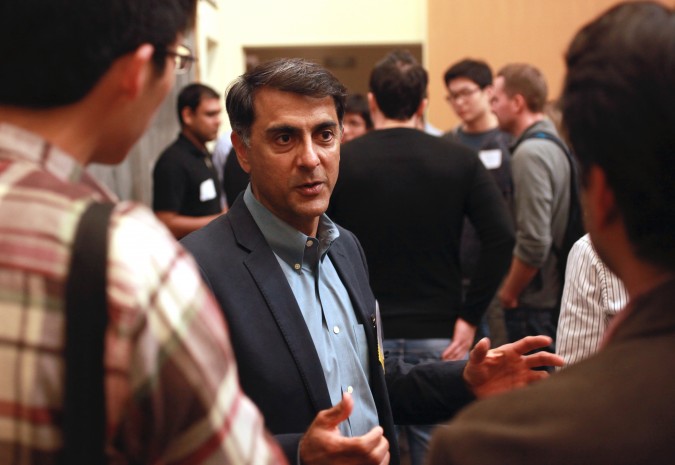
Vivek Mehra, a partner at August Capital, answers questions posed by attendees at the Berkeley Entrepreneurs Forum, August 30, 2012
8. The photographs taken by Bruce Cook, the official photographer, should be publicly posted to Facebook, and should be tagged. Once the identities of the people pictured are known via the tagging, the captions for the official Lester Center website should be updated to identify everyone whose name is known. If required, change the terms of the tickets purchased to give UC Berkeley the right to identify the people by name. Offer an ‘opt out’ list during checkin. Having the names with the pictures will increase traffic to The Lester Center website, since people will search for those names for decades to come. Invite people to tag the pictures in the emails The Lester Center sends out and via Facebook status updates.
9. A vast collection of at least 5,000 of Bruce Cook’s unpublished photographs of the Forum from the last twenty years should be published to Facebook and the Web, and they should be tagged and captioned. This was entirely my idea — Cook did not hint that I propose such an idea. The majority of the pictures published should be of the networking hour, to get as many people from the audiences over the years tagged as possible.
10. The Forum should be oversold, like airplane seats. This August 30th Forum was ‘sold out’ but there were unfilled seats in the auditorium, which takes away from the excitement of a sold out show. If too many people show up, they can watch on video monitors in the Bank of America Forum, and as compensation for not getting a seat, their entrance fee can be 100% refunded. I predict the revenue over time from overbooking will more than make up for the refunds that need to be given. Attendees should be told when they buy their tickets they risk being bumped, and encouraged to arrive early to be sure they get a seat.
11. The reminder to ‘Like’ The Lester Center on Facebook should be repeated on a poster displayed during the Forum. The Forum’s Twitter handle should also be on this poster.
12. Attendees should be given a perk if they follow the Forum on social networks, such as a second drink ticket on their next visit to the Forum, to encourage getting as many followers as possible. Currently attendees may eat unlimited quantities of food at the Forum, but are permitted only one drink, either with alcohol or without.
13. Attendees should be invited to blog and post about the Forums, and The Lester Center site should find and link to the best examples of such efforts, to encourage people to write about the Forum.
I am one of the only bloggers writing about the Forum, but there should be at least several.
14. I love the luxurious food served during the networking hour, but it sure seems like it must cost a fortune. I think it would be more than fine to switch to less fancy food. There is precedent for this. Last year at the Founder School Demo Day what appeared to be inexpensive sandwiches were served, but the event was superb and not diminished by the more everyday food. I suspect the food budget for the Forum could be cut by two thirds without getting more than a handful of complaints. The Forum is still too expensive at USD $25 a ticket, and I bet it loses money even at that price. When I started attending in my mid twenties, the cost was prohibitive. It was only due to my getting free tickets from my employer at the time, Cooley, that I attended regularly. The goal should be to get lots of currently poor entrepreneurs in the making to attend, including but not limited to Berkeley students.
I suggest the price should be no more than $10. To get the price that low, I suggest alcohol should cost extra.
That is all my suggestions for now. The Forum is already a success, or I would not have attended for twenty years. I am trying to make the Forum better.
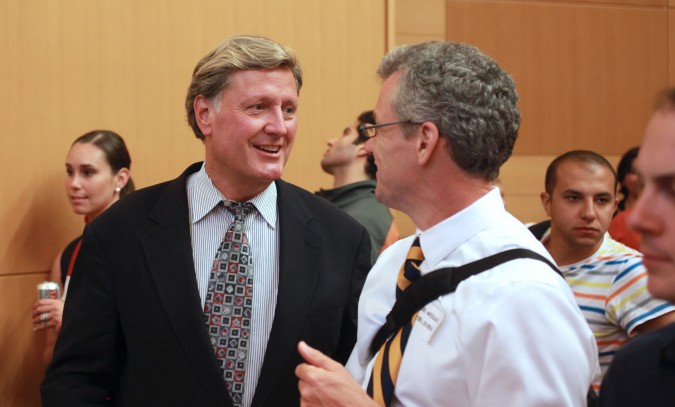
Jeff-Burton, left, the brand new Executive Director of the UC Berkeley Skydeck talks with Andre Marquis, Executive Director of The Lester Center for Entrepreneurship & Innovation, August 30, 2012. Photo by Kevin Warnock.
I upload pictures to this blog at the maximum resolution my camera produces — 21 megapixels. Click on them twice in delayed succession to see them at full size. I shot these pictures at ISO 4,000 due to the low lighting levels.
Click here to see all the posts I have written about the Berkeley Entrepreneurs Forum.
The law firm Fenwick & West LLP where Sam Angus is a partner produced and gave away a great 80 page booklet at the Forum. Retired Fenwick attorney Jacqueline Daunt wrote a fantastic introduction to startups that includes a capitalization table for a hypothetical company from pre-funding stage through a public stock offering. Thank you Fenwick! If I can post this booklet, please let me know and I’ll update this post with a link to a PDF scan of the booklet.
Finally, as an end note, I met Steve Bengston in 1999 during the first dot com boom, when he agreed to help me with Hotpaper, my startup at the time. It turned out I didn’t call on him much, since I lined up financing almost too easily, but I will never forget pitching him at his PriceWaterhouseCoopers office in San Jose, California USA, and him telling me at that meeting that he would help me. Bengston is well known, and I was thrilled to have his support, especially back then when I didn’t know many people or know much of anything.
Why in 1978 I moved to San Francisco from Chicago

The Memorial Church at Harvard University photographed by Flickr.com user Siim Teller, April 22, 2011
Tonight, September 2, 2012, I learned why in 1978 I moved to San Francisco, California USA. I never knew why until today, because I never thought to ask the right questions.
I was born in Chicago, Illinois, USA, at the University of Chicago, where my mother worked as a Pathologist.
My parents had married soon after she graduated from Harvard Medical School, where she was one of five women in a class with 145 men.
My mother met my father Robert Warnock at Harvard, where he earned his PhD in Physics.
My father and my mother got married in The Memorial Church on the Harvard University campus, a church I visited in 2000 when I was in Boston, Massachusetts, USA meeting with storage vendor EMC to discuss an investment by their venture capital division in my startup Hotpaper.
When I visited The Memorial Church, it was just another church. When I told my father about my tour of the Harvard campus, courtesy of my EMC provided limousine with two eager salesman trying to sell me an unnecessary USD $1,000,000 dollar storage array for my startup, my father said ‘your mother and I got married in that church!’
After they wed, my father decided to move with my mother to Chicago so that he could work at the Illinois Institute of Technology (IIT).
My mother was doing research at the University of Chicago, discovering that asbestos is even deadlier than was known at the time. Amazingly, the University of Chicago did not have a spectroscopy attachment for its electron microscope, and my mother needed this device for her research. IIT did have the needed equipment, but they charged money to use it, and IIT was a lengthy drive from our house at 5138 South Dorchester in Hyde Park, on the South side of Chicago. My mother rode her bicycle to University of Chicago, and it would have not have appealed to her to have had to drive to IIT on a frequent and regular basis.
My mother’s research was funded by the National Institutes of Health. I would think that a grant could have been won to order a spectroscopy attachment, but for whatever reason, that was not the path my mother took. Instead, she wrote to a friend she had worked with for a year some twenty years earlier in Seattle, Washington, USA. During that two decade span, that friend had become Chair of the Pathology Department at the University of California at San Francisco.
My mother explained her research and that she had heard that UCSF had a spectroscopy attachment for its electron microscope. My mother asked her friend if she could move to San Francisco and work at UCSF so she could use the required hardware. Her friend said ‘yes,’ and my mother started at UCSF as a full professor.
I learned tonight that my mother was promoted to full professor at University of Chicago just one month before she left for San Francisco. She had been an Associate Professor before that, and I remember as a kid the day my mother was granted tenure. Since I was young, I hadn’t heard that word before, so I thought she said ‘ten year.’ I assumed it was her tenth anniversary of employment. I told my mother that story tonight — perhaps for the first time.
I have a suspicion that University of Chicago panicked when they found out she was leaving for UCSF and rushed through the promotion to full professor, because the timing is so unlikely to have happened naturally. Even if that’s the case, I am sure my mother was pleased that she got to be a full professor at University of Chicago and University of California at San Francisco. My mother retired from UCSF years ago, so is now Professor Emeritus. She still has a website on the UCSF web server.
My mother decided to move our family to San Francisco, since my father had made the decision to move to Chicago. I did not know this until today.
I had always thought we moved to San Francisco because of its reputation as a great cosmopolitan city with superb weather. I had sometimes considered that perhaps UCSF had recruited my mother, but she dispelled that notion today. She did not have to interview for the job at UCSF. She did not have to compete with dozens of candidates. She asked her friend if she could work at UCSF and he said ‘yes.’
I am so thankful my mother needed a piece of equipment that University of Chicago didn’t have. She moved us to the center of the Internet world, and had we stayed in Chicago, I probably would not have become an Internet entrepreneur, which has allowed me to build a richly rewarding life that I cherish.
Thanks Mom! I love you.
Having fun with the Nokia phone ringtone
Much of the modest success I have achieved in life has resulted from Nokia Ventures (later renamed Blue Run Ventures) investing in Hotpaper.com, Inc., which I later sold to Purple Communications.
While that investment was in 1999, I still have a warm spot in my heart for Nokia Ventures and for Nokia the company that makes mobile telephones.
The Nokia default ring tone is so well known and so associated with Nokia phones that I suspect most people in the world can sing the ringtone by heart. That’s assuming the ring tone is the same throughout the world, which I strongly suspect it is.
Watch what happens in this video I found on YouTube when a talented violinist encounters the Nokia ringtone during a public solo performance in front of an audience.
This is a funny video, and you have to watch through to the end for it to be funny.
10 years ago today Mobile Office won a CNET/PC Expo award for Best Business Solution
It was 10 years ago today that a mobile product I helped create — Mobile Office — won a CNET/PC Expo award.
CNET was the TechCrunch of its day.
To commemorate the day 10 years ago I wrote the blog post Mobile Office, a product I helped create, wins CNET/PC Expo Best Business Solution Award.
I wrote the post as I would likely have written it 10 years ago, so I assigned it a publication date of June 28, 2001. I disclosed that fact in an afterword at the bottom of the post.
I am writing this brief additional post to alert you to the ’10 year old post’ that you probably would never see otherwise.
Mobile Office, a product I helped create, wins CNET/PC Expo Best Business Solution award
On August 31, 2000 I sold my Internet company Hotpaper.com, Inc. to GoAmerica, Nasdaq: GOAM. The news was announced the next day.
Hotpaper’s technology was incorporated into the new owners’ product line. The new product is called Mobile Office. One of the features of Mobile Office gives users the ability to perform sophisticated document assembly on a Palm or Blackberry PDA. To my knowledge Hotpaper invented and was the first to reduce to practice document assembly solutions for mobile devices.
I created the first prototype for mobile document assembly in about 1998 when I attached with Velcro hook and loop fasterner material a Ricochet Internet service radio to the bottom of my Palm III non wireless Portable Digital Assistant. I used the HandWeb web browser to access a stripped down website document assembly website I built. I used Microsoft Word ’97 running on the web server for core document assembly functionality. Word mail merge fields are very powerful. If/then/else blocks may be nested 10 levels deep, for example.
My prototype worked fine and was reliable, but it was painfully slow.
The Ricochet wireless data network my radio could connect to operated at best at 28K, but I suspect it was more like 9.6K on a normal day. I demonstrated the handheld assemblage to my friend Jerry Engel, the Executive Director at the Lester Center for Entrepreneurship and Innovation at the Haas School of Business at the University of California at Berkeley. His office is in a huge concrete and steel building, so the network was even slower than normal, but when I stepped into the hallway it worked, and I was able to draft a nicely formatted Microsoft Word document with embedded graphics and email it to Engel, all wirelessly. I recall he was impressed. Not long thereafter, Engel joined the board of advisors for Hotpaper.
I relate this early history to show how long I’ve been fascinated with mobile productivity solutions.
I am proud that an idea I conceived of years ago is now a polished commericial product sold by a noteworthy public company that’s a leader in wireless connectivity solutions.
I am particularly proud that today both CNET and PC Expo have voted Mobile Office the Best Business Solution of 2001. Here’s a screen shot of the press release, to guard against the story being deleted in the future.
Mobile Office has a lot of features, and my technology is only part of the overall offering. But I think it’s fair to say that Mobile Office would not have won this award if not for my technology, because my technology is the unique feature that makes you take notice — being able to complete richly formatted Word documents pages in length using a small handheld device like the Blackberry. To my knowledge, there is no competing service in the world today.
###
I wrote this article June 28, 2011, ten years after the date that appears on this article.
I wrote this article to commemorate what was big news for me in 2001. To learn more about my sale of Hotpaper to GoAmerica, please read Hotpaper, my first Internet company gets acquired, published in 2011.
I hadn’t thought much about the CNET win until June 27, 2011 when I was telling my friend Kevin Casey about the history of Hotpaper. I didn’t notice today marks the 10 year anniversary of the CNET win announcement until I was nearly finished writing the article. What an astounding coincidence.
Thank you to GoAmerica’s Joe Korb for suggesting to me late one night in May 2000 that GoAmerica acquire Hotpaper.
GoAmerica is still in business but is now known as Purple Communications. Purple is a leading provider of communications services to people with hearing disabilities.
Kevin Warnock
